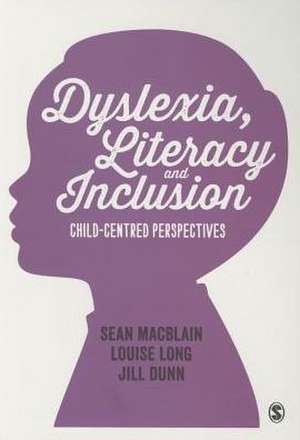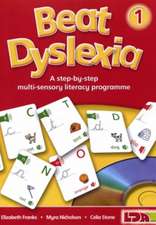Dyslexia, Literacy and Inclusion: Child-centred perspectives
Autor Sean MacBlain, Louise Long, Jill Dunnen Limba Engleză Paperback – 5 apr 2015
- Early intervention
- Pupil voice
- Working as a team
- New literacies
- Child-centred identification, assessment and provision
- Challenges for the inclusive school.
| Toate formatele și edițiile | Preț | Express |
|---|---|---|
| Paperback (1) | 290.51 lei 3-5 săpt. | +22.20 lei 7-11 zile |
| SAGE Publications – 5 apr 2015 | 290.51 lei 3-5 săpt. | +22.20 lei 7-11 zile |
| Hardback (1) | 856.31 lei 6-8 săpt. | |
| SAGE Publications – 5 apr 2015 | 856.31 lei 6-8 săpt. |
Preț: 290.51 lei
Nou
Puncte Express: 436
Preț estimativ în valută:
55.59€ • 58.04$ • 45.90£
55.59€ • 58.04$ • 45.90£
Carte disponibilă
Livrare economică 25 martie-08 aprilie
Livrare express 11-15 martie pentru 32.19 lei
Preluare comenzi: 021 569.72.76
Specificații
ISBN-13: 9781446298435
ISBN-10: 1446298434
Pagini: 232
Dimensiuni: 170 x 242 x 14 mm
Greutate: 0.39 kg
Ediția:1
Editura: SAGE Publications
Colecția Sage Publications Ltd
Locul publicării:London, United Kingdom
ISBN-10: 1446298434
Pagini: 232
Dimensiuni: 170 x 242 x 14 mm
Greutate: 0.39 kg
Ediția:1
Editura: SAGE Publications
Colecția Sage Publications Ltd
Locul publicării:London, United Kingdom
Recenzii
This book is a very valuable resource for a wide range of professionals (including student teachers and teachers) to better address the needs of pupils with dyslexia, including those in the Early Years. The authors give a very detailed examination of dyslexia and the wider issues affecting the pupil, the family and society. Policies influencing the education of dyslexic pupils are discussed, as are major relevant issues such as poverty. Clear real life examples are well used to aid understanding and the structure of each chapter allows the reader to reflect on what they have been reading through exercises, suggestions for further reading and useful websites and video material which are freely available.
The authors have presented a text which will not only assist anyone studying dyslexia but will help professionals to enhance their understanding and professional practice and thereby raise standards in pupils with dyslexia.
I work with both undergraduates and postgraduates and would be very keen to use this highly accessible book within each of the courses. In Wales, of course, the comments on the statutory framework with Early Years would need to be set in the context of our Framework for the Foundation Phase but the sense of the content and the focus on dyslexia would be appropriate to the early years of teaching and learning, regardless of the differing contexts.
This is a clear, concise approach to the discussion on dyslexia and literacy. The child is central to the thinking here; whilst the novice practitioner is given an introduction to the issues, the mature practitioner is challenged to review their outlook and look afresh. I cannot wait for my own copy.
This is a very accessible text that engages the reader in a child centered and holistic issues and approached. It is full of valuable information that professionals (both in preparation and more experienced) will find helpful as they meet the needs of this group of learners in inclusive settings. The literacy focus is particularly important and contributes to our goal of raised standards and high expectations for learners with dyslexia. The perspective of the children themselves is something that raises the quality of the book and a reason why I will recommend it to the teachers I work with!
This is a very important book which offers a refreshingly honest account of the current challenges facing children with dyslexia and developmental literacy difficulties. It acknowledges the conceptual confusion which continues to surround this area, but rightly places an emphasis on understanding the holistic needs of the child in a changing familial and cultural context, and of seeking to meet those needs in a child-friendly, rights-respecting manner. In so doing practitioners are encouraged to appreciate and address the potentially significant emotional impact of dyslexia and literacy difficulties on children, to learn the lessons from the critical reviews of the most recent international research in this field, and to embrace new technologies and popular culture to enhance motivation and self-esteem while offering new learning opportunities. I would thoroughly recommend this book.
This is a well-written book that focuses on early years and the primary sector and provides much information and guidance as well as raising important issues about how dyslexia can be reframed in the 21st Century.
The authors have presented a text which will not only assist anyone studying dyslexia but will help professionals to enhance their understanding and professional practice and thereby raise standards in pupils with dyslexia.
I work with both undergraduates and postgraduates and would be very keen to use this highly accessible book within each of the courses. In Wales, of course, the comments on the statutory framework with Early Years would need to be set in the context of our Framework for the Foundation Phase but the sense of the content and the focus on dyslexia would be appropriate to the early years of teaching and learning, regardless of the differing contexts.
This is a clear, concise approach to the discussion on dyslexia and literacy. The child is central to the thinking here; whilst the novice practitioner is given an introduction to the issues, the mature practitioner is challenged to review their outlook and look afresh. I cannot wait for my own copy.
This is a very accessible text that engages the reader in a child centered and holistic issues and approached. It is full of valuable information that professionals (both in preparation and more experienced) will find helpful as they meet the needs of this group of learners in inclusive settings. The literacy focus is particularly important and contributes to our goal of raised standards and high expectations for learners with dyslexia. The perspective of the children themselves is something that raises the quality of the book and a reason why I will recommend it to the teachers I work with!
This is a very important book which offers a refreshingly honest account of the current challenges facing children with dyslexia and developmental literacy difficulties. It acknowledges the conceptual confusion which continues to surround this area, but rightly places an emphasis on understanding the holistic needs of the child in a changing familial and cultural context, and of seeking to meet those needs in a child-friendly, rights-respecting manner. In so doing practitioners are encouraged to appreciate and address the potentially significant emotional impact of dyslexia and literacy difficulties on children, to learn the lessons from the critical reviews of the most recent international research in this field, and to embrace new technologies and popular culture to enhance motivation and self-esteem while offering new learning opportunities. I would thoroughly recommend this book.
This is a well-written book that focuses on early years and the primary sector and provides much information and guidance as well as raising important issues about how dyslexia can be reframed in the 21st Century.
Cuprins
SECTION 1: NEW HORIZONS FOR PUPILS WITH DYSLEXIA
Chapter 1: Changing experiences in childhood: challenges for the 21st Century, Sean MacBlain
Chapter 2: Child-centred literacy pathways: pupils’ perspectives, Louise Long
Chapter 3: Meeting the needs of children with dyslexia and developmental literacy difficulties: holistic approaches, Sean MacBlain
SECTION 2: BUILDING CAPACITY TO RAISE LITERACY STANDARDS FOR CHILDREN WITH DYSLEXIA AND DEVELOPMENTAL LITERACY DIFFICULTIES
Chapter 4: Child-centred approaches to the identification and assessment of dyslexia and developmental literacy difficulties, Sean MacBlain and Louise Long
Chapter 5: Raising literacy standards: perspectives on best practice, Sean MacBlain, Louise Long and Jill Dunn
Chapter 6: Advancing inclusive cultures for literacy learning in the mainstream primary school, Louise Long
SECTION 3: LITERACY IN CONTEMPORARY SETTINGS
Chapter 7: New literacies in the classroom: forging culturally responsive curricula, Jill Dunn
Contemporary Challenges: Looking to the Future, Sean MacBlain and Jill Dunn
Chapter 1: Changing experiences in childhood: challenges for the 21st Century, Sean MacBlain
Chapter 2: Child-centred literacy pathways: pupils’ perspectives, Louise Long
Chapter 3: Meeting the needs of children with dyslexia and developmental literacy difficulties: holistic approaches, Sean MacBlain
SECTION 2: BUILDING CAPACITY TO RAISE LITERACY STANDARDS FOR CHILDREN WITH DYSLEXIA AND DEVELOPMENTAL LITERACY DIFFICULTIES
Chapter 4: Child-centred approaches to the identification and assessment of dyslexia and developmental literacy difficulties, Sean MacBlain and Louise Long
Chapter 5: Raising literacy standards: perspectives on best practice, Sean MacBlain, Louise Long and Jill Dunn
Chapter 6: Advancing inclusive cultures for literacy learning in the mainstream primary school, Louise Long
SECTION 3: LITERACY IN CONTEMPORARY SETTINGS
Chapter 7: New literacies in the classroom: forging culturally responsive curricula, Jill Dunn
Contemporary Challenges: Looking to the Future, Sean MacBlain and Jill Dunn
Descriere
With case study examples that cover early years and primary, this book takes a child-centred approach by putting the focus on emotional well-being, offering individual strategies for raising literacy standards among children with dyslexia.
















